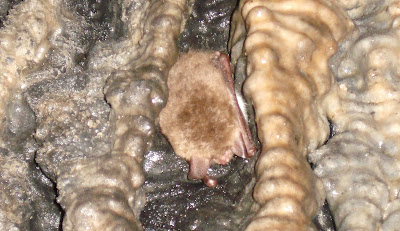The occasion was one of the regular Bat hibernation surveys carried out by the Bedfordshire Bat Group. Soon after 9.30am, Bob, Soggy, Jon, Peter & I set off in a northerly direction from Ampthill – our mission: to visit 3 ice-houses in the morning and another prime hibernation site in the afternoon.
We made our way to the first location through a small cottage garden where Snowdrops and Winter Aconites were flowering, and then into the quaint little ice-house itself. There we found 9 hibernating Peacock Butterflies, 4 hibernating Herald Moths…and 1 hibernating Brown Long-eared Bat! Result!
And so, by the time we arrived at our second site, I’d already got the bug or, in this case, the bat! This ice-house dated back to the early 1800s. More recently, it was here that Bedfordshire’s first Barbastelle Bat was recorded in 1994…the species that I was most hoping to catch up with today, so I was quite excited as we made our way into the entrance tunnel. There, in the crumbling brickwork we found another Brown Long-eared Bat and 2 Natterer’s Bats. The main chamber was flooded and we prevaricated over whether it would be worth setting up the ladder in the water. We decided to go for it and our diligence was rewarded when Jon, standing on a rung below the waterline, was able to pick out 3 more Natterer’s Bats huddled together in a gap above the lintel….satisfaction all round!
The last ice-house was situated in the middle of a field. After tending to a dying lamb in the entrance, we descended into the chamber, taking care to avoid the rows of rotting wooden shelves dating back to the years when the ice-house was converted to an apple store. There are no apples nowadays, but a bat brick set in the ceiling contained yet another Brown Long-eared Bat…which all goes to show that there’s a bit of to-ing and fro-ing going on even in the cold weather we’ve been experiencing, because the same bat brick yielded not a Brown Long-eared Bat, but 2 Natterer’s Bats during the January survey!
At the last site we were joined by Katharine and, after enjoying our sandwiches and a hot drink, we made our way to the location, which has produced good numbers of hibernating bats year on year. It was big and dark, and not the sort of place you’d want to be on your own, especially if you’ve got an over-active imagination, but it made for a fascinating period of time searching the various nooks and crannies! By the time we had finished, we had recorded 49 Bats. Natterer’s Bats were the most commonly encountered species, with 31 individuals recorded, their lighter pelage, longer outward-pointing ears, and extended snouts with little pink noses contrasting with the 9 smaller and duller Daubenton’s Bats that we came across. There was also another Brown Long-eared Bat tucked away behind a plank in the ceiling high above us, and a Pipistrelle species in a regular crevice between two bricks.
 Here is one of the Natterer's Bats which was hibernating in a surprisingly damp position! [Photo by Jon Durward]
Here is one of the Natterer's Bats which was hibernating in a surprisingly damp position! [Photo by Jon Durward] But the stars of the show for me were the 5 Barbastelles with their dark frosted fur and pointed ears, including this wonderful individual [Photo by Jon Durward]. Natterer’s Bats are named after their discoverer, Johann Natterer, but Barbastelles have been named much more creatively, arising either from the Latin for Star Beard, a reference to the white tips to the fur which results in their frosted appearance, or else Little Beard because of the appearance of the long fur on the relatively small faces.
But the stars of the show for me were the 5 Barbastelles with their dark frosted fur and pointed ears, including this wonderful individual [Photo by Jon Durward]. Natterer’s Bats are named after their discoverer, Johann Natterer, but Barbastelles have been named much more creatively, arising either from the Latin for Star Beard, a reference to the white tips to the fur which results in their frosted appearance, or else Little Beard because of the appearance of the long fur on the relatively small faces.What an incredible day: I’m privileged to have been given some fantastic views of one of our most fascinating families of mammals and, in so doing, I have fulfilled an ambition that I have been nursing for a very long time. I have also been given a real insight into the vital work carried out by the Bedfordshire Bat Group. It’s a privilege to be a part of it now, and I’ve no doubts that I will grasp many future opportunities to engage in various bat-related initiatives. Watch this space!
No comments:
Post a Comment